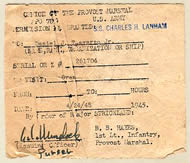Voyage Eight
Charles H. Lanham - Page 2
The Chief Engineer had only his thumb and his little finger on one hand. He had lost the rest in an accident. He used to hold that hand up to shield the glare on the glass faces of the gages when he checked them. I nick-named him the "claw". There was a nice boy from Galveston in the crew named Robert Alvarado. I could really make him laugh when I'd say "here comes the claw." But I really did like the Chief - he was a good old man.
The war in Europe was almost over. Everybody knew that it was just a matter of weeks before it ended as the Allied Armies were fighting deep inside of Germany at the time. There was still scattered U-boat activity but nothing compared to earlier. On April 8, 1945 the SS Charles H. Lanham sailed from Norfolk, Virginia for the Mediterranean. After she passed Gibraltar, for the first time during the war, running lights were shown. She arrived at Oran, Algeria on April 24, 1945.
North Africa was a hell-hole as far as I was concerned. I thought that it must be the worst place in the world, but that was before I got to the Philippines. When we went ashore they told us to be careful of the Arabs. There were robberies and murders. While we were there they found two soldiers in a jeep at the end of the wharf with their throats cut and stripped naked. The Arabs were after weapons but had taken everything. The French and the Arabs didn't get along at all. There was a lot of revolt going on as the Arabs wanted their independence. Some of the French troops, especially the Foreign Legion, treated the Arabs pretty brutally.
Armed Guard Report of Lt. Jack Murphy: "Lost 44 hrs, 30 mins discharging time in Oran Algeria prior to sailing for Nemours due to joint Navy- W.S.A. foul up while authorities were trying to decide whether to finish unloading grain in the cargo from the United States in Oran or route the vessel to some other port. Stevedores worked only 8 hrs per day loading cargo in Oran for Marseille and handling of cargo was not too efficient. Berth 12 at Oran, which is the location of the grain suckers, will not accommodate vessel drawing more than 24 feet of water and for that reason vessels containing bulk grain must be unloaded on barges before shifting vessel to berth 12- if the draught is more than 24 feet. The Lanham left Oran for Nemours, Algeria on 4 May 1945 and returned to Oran on the 6th.
While we were in North Africa they had us tied up between a Russian and a Greek ship. We were side to side and you had to walk over the decks of the other ships to get to the pier - the Russians had to come over our deck to get to their ship. One morning the Russian ship was gone and so was everything we had on board that wasn't bolted down. They took all the silverware, dishes, pots and pans, even the toasters - linen, whatever they could walk off with.
Convoys that I sailed in had ships of many nationalities - all the Allied nations and sometimes neutrals, too. Next to the British there were lots of Norwegians, they had a big Merchant Navy. There were French, Danish, Dutch, Belgium, Panamanian, Greek and South African ships. I was lucky to get to go home and see my wife and family several times during the war. Many U. S. military didn't see their loved ones for the duration. The seaman from countries occupied by the Germans, like the Norwegians and the Greeks spent years away from home. All they had was their ships. I felt sorry for those guys, out there doing their job and worrying about their families and not knowing what was happening to them back home.




